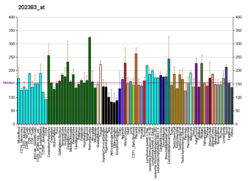KDM5C
gène de l'espèce Homo sapiens
Le KDM5C (pour « Lysine-specific demethylase 5C ») ou JARID1C, ou XE 169, est une protéine dont le gène est le KDM5C situé sur le chromosome X humain.
Structure et rôles modifier
Il existe plusieurs isoformes par épissage alternatif. Le chromosome Y humain contient une séquence proche. Il s'agit de l'un des gènes échappant au phénomène d'inactivation du chromosome X[5].
Il a une activité de histone H3 lysine 4 déméthylase[6].
En médecine modifier
La mutation du gène entraîne un retard mental familial à transmission dominante liée à l'X[7]. Près de 20 mutations de ce type ont été décrites, entraînant une baisse de l'activité de déméthylase de cet enzyme[8].
Notes et références modifier
- GRCh38: Ensembl release 89: ENSG00000126012 - Ensembl, May 2017
- GRCm38: Ensembl release 89: ENSMUSG00000025332 - Ensembl, May 2017
- « Publications PubMed pour l'Homme », sur National Center for Biotechnology Information, U.S. National Library of Medicine
- « Publications PubMed pour la Souris », sur National Center for Biotechnology Information, U.S. National Library of Medicine
- Wu J, Ellison J, Salido E, Yen P, Mohandas T, Shapiro LJ, Isolation and characterization of XE169, a novel human gene that escapes X-inactivation, Hum Mol Genet, 1994;3:153–160
- Iwase S, Lan F, Bayliss P et al. The X-linked mental retardation gene SMCX/JARID1C defines a family of histone H3 lysine 4 demethylases, Cell, 2007;128:1077–1088
- Jensen LR, Amende M, Gurok U et al. Mutations in the JARID1C gene, which is involved in transcriptional regulation and chromatin remodeling, cause X-linked mental retardation, Am J Hum Genet, 2005;76:227–236
- Rujirabanjerd S, Nelson J, Tarpey PS et al. Identification and characterization of two novel JARID1C mutations: suggestion of an emerging genotype-phenotype correlation, Eur J Hum Genet, 2010;18:330–335





